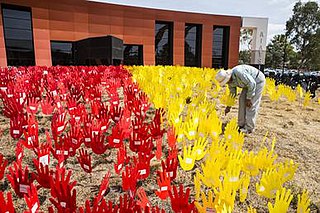The Wilson River language is an Australian Aboriginal language of the Karnic family. It was spoken by several peoples along the Wilson River in Queensland. Of these, the Wangkumara and Galali may have migrated from the Bulloo River and abandoned their language when they arrived.
Worimi, or Gadjang is an Australian Aboriginal language. It is the traditional language of the Worimi people, whose descendants now speak English.
Kuku-Thaypan is an extinct Paman language spoken on the southwestern part of the Cape York Peninsula, Queensland in Australia, by the Kuku-Thaypan people. The language was sometimes called Alaya or Awu Alaya. Koko-Rarmul may have been a dialect, though Bowern (2012) lists Gugu-Rarmul and Kuku-Thaypan as separate languages. The last native speaker, Tommy George, died 29 July 2016 in Cooktown Hospital.
Ngardi (Ngarti) or Ngardilj, also called Bunara, is a moribund Australian Aboriginal language.

The Nyungic languages are the south-westernmost of the Australian Aboriginal languages:

The Paman languages (/pamən/) are an Australian language family spoken on the Cape York Peninsula of Queensland. First noted by Kenneth Hale, Paman is noteworthy for the profound phonological changes which have affected some of its descendants.

The Darling language, or Paakantyi (Baagandji), is a nearly extinct Australian Aboriginal language spoken along the Darling River in New South Wales from present-day Bourke to Wentworth and including much of the back country around the Paroo River and Broken Hill. The people's and language name refers to the Paaka with the suffix -ntyi meaning 'belonging to',

Maran or Maric is a extinct branch of the Pama–Nyungan family of Australian languages formerly spoken throughout much of Queensland by many of the Murri peoples. The well attested Maric languages are clearly related; however, many languages of the area became extinct before much could be documented of them, and their classification is uncertain. The clear Maric languages are:
Gugadj (Kukatj), or Kalibamu, is an extinct Paman language of the Cape York Peninsula, Queensland, Australia.

Bayali is an extinct language of Queensland in Australia, spoken in the Rockhampton area. It has been classified together with Darumbal as a Kingkel language, but the two are not close, and Bowern (2011) reclassified Darumbal as a Maric language.
Ngura is a disputed and possibly spurious ethnic and language designation of central Australia. The name 'Nura', short for Ngurawarla, means 'empty camp', referring to lands abandoned after a massacre. It is not a language or ethnic designation.
Yandruwandha is an Australian Aboriginal language of the Pama–Nyungan family. Yawarawarga is considered a dialect by Dixon (2002), a closely related language by Bowern (2001).
Dyirringany (Djiringanj) is an extinct Australian Aboriginal language of New South Wales. It is not listed in Bowern (2011), but the people are ethnically Yuin. The only attestation of the language are manuscripts and a grammar dating from 1902. It is sometimes classified with Thawa as a dialect of Southern Coastal Yuin.
Mithaka (Midhaga) is an extinct Australian Aboriginal language.
Badjiri is an extinct language from Queensland Australia. Bowern suspects it's a Maric language. Bowern (2001) said the data was too sketchy to be sure, but Bowern (2011) assigned it to Maric without comment.
Uwinymil is an Australian Aboriginal language spoken of Arnhem Land.
Walangama is an extinct Paman language of the Cape York Peninsula, Queensland. It may have been one of the Southern Paman languages, but is poorly attested.

The Garawan languages (Garrwan), or Yanyi, are a small language family of Australian Aboriginal languages currently spoken in northern Australia.
Bindal is an Australian Aboriginal language of Queensland. Bowern suggests that it might have been a Maric language. Breen presumes that one of two Lower Burdekin languages, which he concluded were not Maric, is Bindal.
Himberrong is a clan of the Anēwan Aboriginal tribe of what is now known as the New England Tablelands region in northeast New South Wales.








